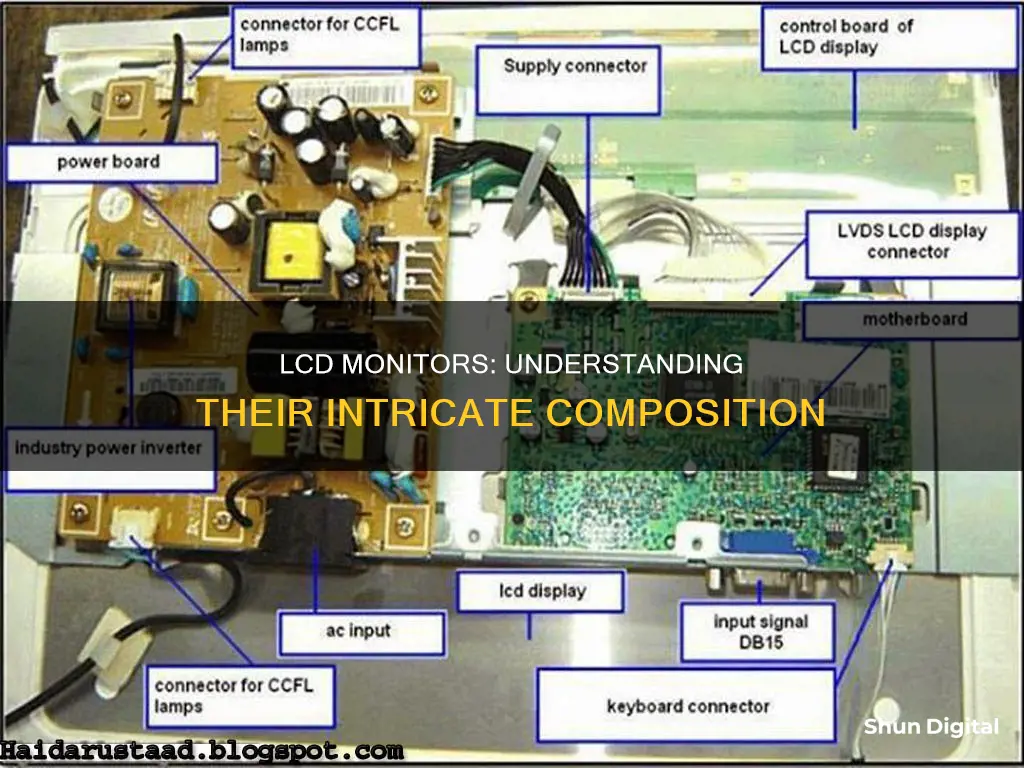
LCD monitors are made of a substance that is permanently in a liquid state but has some properties inherent in crystal bodies. They are made of two pieces of polarized glass (or substrate) that contain a thin layer of liquid crystals between them. The liquid crystals are affected by electric currents, which cause them to align and allow varying levels of light to pass through, creating the colours and images that we see. The liquid crystal panel is illuminated by a light source, which is usually a backlight, and the plane of polarization of the light beam is rotated by 90° as it passes through the panel.
What You'll Learn
- LCD monitors are made of two pieces of polarised glass with liquid crystals between them
- They are lit by a backlight and pixels are switched on and off electronically
- LCDs are made with either a passive or active matrix display grid
- LCDs are now being replaced by other display technologies, such as OLEDs
- LCDs are used in TVs, computers, tablets, smartphones, watches, and more

LCD monitors are made of two pieces of polarised glass with liquid crystals between them
The two pieces of polarised glass are also called substrates. The substrate contains a thin layer of liquid crystals between them. The panels have flutes that direct the crystals, giving them a distinctive orientation. The flutes are parallel on each panel but perpendicular to one another. This is achieved by placing thin films of transparent plastic on the glass surface, which are then processed in a particular way.
The liquid crystal panel is illuminated by a light source, and the plane of polarisation of the light beam is rotated by 90 degrees as it passes through the first panel. When an electric field is applied, the molecules partially align with it, and the angle of rotation of the plane of polarisation of light changes. By using a backlight, light is generated at the back of the LCD monitor to output a colour image.
LCD monitors are made with either a passive matrix or an active matrix display grid. The active matrix LCD is also known as a thin-film transistor (TFT) display. The passive matrix LCD has a grid of conductors with pixels located at each intersection in the grid. A current is sent across two conductors on the grid to control the light for any pixel. An active matrix has a transistor located at each pixel intersection, requiring less current to control the luminance of a pixel. For this reason, the current in an active matrix display can be switched on and off more frequently, improving the screen refresh time.
Repairing LCD Monitors: Replacing CCFL Lights
You may want to see also

They are lit by a backlight and pixels are switched on and off electronically
LCD monitors are lit by a backlight, with pixels being switched on and off electronically. This is achieved through the use of liquid crystals, which rotate polarised light. A polarising glass filter is placed in front and behind all the pixels, with the front filter placed at 90 degrees to the back filter. In between the two filters are the liquid crystals, which can be electronically switched on and off.
The backlight of an LCD monitor creates light that passes through the first substrate. Electrical currents then cause the liquid crystal molecules to align, allowing varying levels of light to pass through to the second substrate, creating the colours and images that we see. The liquid crystal molecules are aligned between two transparent electrodes, which are often made of indium tin oxide.
The way a pixel is controlled differs in each type of display. In LCD monitors, the pixels are electronically switched on and off, with liquid crystals rotating polarised light. The liquid crystals in an LCD produce an image using a backlight. This is in contrast to an LED, which emits light.
LCD monitors are made of a substance that is permanently in a liquid state but has some properties inherent in crystal bodies. The internal construction of an LCD describes how the light is altered when it passes through it, to produce characters, images and video. LCD screens are made up of an array of small segments called pixels, which can be manipulated for information display.
LCD screens have several layers, with two panels made of glass material that is free of sodium, called the substrate, playing a crucial role. The substrate contains a thin layer of liquid crystals between them. The panels have flutes that direct the crystals, giving them a distinctive orientation. The liquid crystal panel is illuminated by a light source, depending on where it is located, as the LCD panels operate on reflection or light transmission. The plane of polarisation of the light beam is rotated by 90 degrees as one panel passes. When an electric field appears, the molecules are partially aligned along it, and the angle of rotation of the plane of polarisation of light becomes different from 90 degrees.
LCD monitors use active matrix or passive matrix technology. Active matrix LCDs, also known as thin-film transistor displays, have a transistor located at each pixel intersection, requiring less current to control the luminance of a pixel. Passive matrix LCDs, on the other hand, use a grid of conductive metal to charge each pixel.
Monitor Size Requirements for Smooth QuickBooks Operations
You may want to see also

LCDs are made with either a passive or active matrix display grid
LCDs are made with either a passive matrix or an active matrix display grid. The active matrix LCD is also known as a thin-film transistor (TFT) display. The passive matrix LCD has a grid of conductors with pixels located at each intersection in the grid. A current is sent across two conductors on the grid to control the light for any pixel. An active matrix, on the other hand, has a transistor located at each pixel intersection, requiring less current to control the luminance of a pixel. This is why the current in an active matrix display can be switched on and off more frequently, improving the screen refresh time.
The passive matrix was the first type of LCD technology. This type of LCD display uses a grid of conductive metal to charge each pixel. Although they are less expensive to produce, passive matrix monitors are rarely used today due to the technology's slow response time and imprecise voltage control compared to active matrix technology.
The active matrix is the most common type of LCD technology today. A thin film transistor (TFT) arranges tiny transistors and capacitors in a matrix on the glass of the display. To address a particular pixel, the proper row is switched on, and then a charge is sent down the correct column. Since all of the other rows that the column intersects are turned off, only the capacitor at the designated pixel receives a charge. The capacitor is able to hold the charge until the next refresh cycle.
Some passive matrix LCDs have dual scanning, meaning that they scan the grid twice with current in the same time that it took for one scan in the original technology. However, active matrix is still a superior technology out of the two.
Monitors: Choosing the Right Screen Size for You
You may want to see also

LCDs are now being replaced by other display technologies, such as OLEDs
Liquid-crystal displays (LCDs) are a type of flat-panel display that uses liquid crystals in its primary form of operation. LCDs are available to display arbitrary images or fixed images with low information content. They use the same basic technology, except that arbitrary images are made from a matrix of small pixels, while other displays have larger elements. Each pixel of an LCD typically consists of a layer of molecules aligned between two transparent electrodes, often made of indium tin oxide (ITO) and two polarizing filters. The liquid crystals do not emit light directly but instead use a backlight or reflector to produce images in color or monochrome.
LCDs are now being replaced by other display technologies, such as organic light-emitting diodes (OLEDs). OLEDs use a single glass or plastic panel, compared to LCDs, which use two. Since an OLED does not need a backlight like an LCD, OLED devices such as televisions are typically much thinner, and have much deeper blacks. This is because each pixel in an OLED display is individually lit. If the display is mostly black on an LCD screen, but only a small portion needs to be lit, the whole back panel is still lit, leading to light leakage on the front of the display. An OLED screen avoids this, along with having better contrast and viewing angles and less power consumption. With a plastic panel, an OLED display can be bent and folded over itself and still operate. However, OLED displays tend to be more expensive and can suffer from burn-in, as plasma-based displays do.
Another emerging display technology is MicroLED. MicroLED combines the best features of current TV technologies into something new and huge. Using millions of tiny individually addressable LEDs, MicroLED promises to rival the picture quality of OLED, the current champion, but with better brightness and a lower chance of burn-in. MicroLED is made of millions of micro LEDs—tinier versions of what's in your current LCD TV, or newer flashlights, light bulbs, and myriad other devices to create light. While MicroLED is currently huge and expensive, it is getting smaller and cheaper.
Choosing Monitors for a Cozy 9x9 Room
You may want to see also

LCDs are used in TVs, computers, tablets, smartphones, watches, and more
LCDs are used in a wide range of applications, from TVs to computers, tablets, smartphones, watches, and more. Their versatility and popularity stem from several advantages they offer over other display technologies. Firstly, LCDs are thinner and lighter than their predecessors, such as cathode ray tubes (CRTs), making them ideal for portable devices. Additionally, LCDs consume less power, which is crucial for battery-operated devices like tablets and smartphones.
LCDs have become a standard for television screens and computer monitors due to their ability to produce high-quality images with improved contrast, brightness, and clarity. LCD technology has also enhanced the viewing experience on smaller screens, such as digital cameras, watches, and calculators, by offering sharper text and better color accuracy.
The use of LCDs extends beyond traditional display devices. For example, LCD screens are now commonly found in car navigation systems and e-book readers. The versatility of LCDs is further demonstrated by their integration into ovens, CD players, and other electronic devices.
The popularity of LCDs can also be attributed to their cost-effectiveness. While newer display technologies like OLEDs offer enhanced features, LCDs remain a more affordable option for consumers, especially when considering larger screen sizes.
Despite the emergence of competing technologies, LCDs continue to evolve and maintain their relevance in the display market. Manufacturers have introduced advancements such as in-plane switching (IPS) and vertical alignment (VA) panels, improving viewing angles, color reproduction, and contrast ratios.
In summary, LCDs have revolutionized the way we interact with visual information by providing thin, lightweight, and energy-efficient displays for a diverse range of devices. Their adaptability and ongoing improvements ensure that LCDs will remain a prominent player in the display industry for the foreseeable future.
How to Monitor Data Usage on iPhone 6
You may want to see also
Frequently asked questions
LCD monitors are made of two pieces of polarized glass (or substrate) with a liquid crystal material between them. The substrate contains a thin layer of liquid crystals between them.
A backlight creates light that passes through the first substrate. Electrical currents cause the liquid crystal molecules to align and allow different levels of light to pass through to the second substrate, creating colours and images.
There are two main types of LCD technology: active matrix and passive matrix. Active matrix LCDs are also known as thin-film transistor (TFT) displays. Passive matrix LCDs are less common today due to their slow response time and imprecise voltage control.
LCD monitors are thinner, lighter, and more energy-efficient than older display technologies like cathode ray tubes (CRTs). They also have a faster response time and better colour accuracy than some other display types.







